-

人教版新目标初中英语八年级下册Why don’t you get her a scarf教案
教师带领学生复习有关描述宠物的词汇,采用教师提问学生回答的方进行。如:T:What animals do you think would be good pets?What animals do you think would be bad pets?What do you think are good animals for a six-year-old child?然后学生进行 pairwork 练习。Task two: 师生互动,学习探究 1、播放3a部分的录音,引导学生一边听录音,一边跟读。2、通过听录音学生回答以下问题:Why do you think pot-bellied pigs are popular?What are the advantages and disadvantages of keeping such a pet?教师对学生的回答进行及时点评。3.学习范文,学习重点短语,为下步的模仿写作提供语言素材。T :1. )Have you ever kept a pig as a pet?Do you like pigs? St.:No.…Why don’t you like to keep a pig? St: No.They’re too dirty and lazy(Do you know in some foreign countries like Hollyland, Australia,pigs are the most popular pet.there’s a kind of pig.(图)it has an interesting name? it ‘s called a pot-bellied pig.) Now,let’s learn an article about this kind of interesting pet.2.)play the tapeSt.:Listen and repeat3.)show some Qs on computer(本子St.: read silently,then answerthe Qs(本子)4.)Ask ss. Close book and retell this passage.(what is a pot-bellied pig? Is it a good or bad pet? ) St.: retell it to each other“A pot –bellied pig is a popular pet now…”5.read the article together.St.:.practice reading

人教版新目标初中英语九年级下册Could you please tell me where the restrooms are教案
Step Ⅰ RevisionCheck homework. Ask a few students to read the article in 3a.Then ask a few students to read their guides.Step Ⅱ Part 1Look at the words in the box. Ask a student to read them. Make sure the students understand the meaning of the words. You are to fill in the blanks with the words. In some cases, students may need to use another form of the word, for example adjusting for tense or subject/ verb agreement.Ask students to fill in the blanks on their own.Check the answers. Step ⅢPart 2Go through the instructions with the class.Look at the example with the students.Ask students what the answer would be.Ask a student to read the question and answer it.Excuse me, could you tell me where the bank is, please?The bank is across the street from the shopping malt.Get students to complete the work in pairs.Check the answers. Ask a few students to read their questions.Step Ⅳ Just for Fun!Ask all the students to read the conversation. Ask: What is funny about this cartoon? Help students to explain. A Martian is a person from the planet Mars.There is no such thing as Martian food on Earth, and the clerk looks silly because he is trying to think of where there is a Martian restaurant.Invite some pairs of students to present this conversation to the rest of the class.Step Ⅴ Summary and HomeworkIn this class, we’ve done much writing practice using the key vocabulary words and the target language presented in this unit. After class, please finish the questions in 2 in your exercise books. Then finish the exercises on pages 47~48 of the workbook as well.The Seventh Period Ⅰ Teaching Aims and Demands1. Knowledge Objects(1) Key Vocabularyimage, adventure, jealousy, hero, crime, journey, brave, no longer, show interest in, take it easy, become interested in, plain looks(2)Text:Grown-ups like cartoons, too.2. Ability Objects(1) Fast-reading to get a general idea of the text.(2) Careful-reading to get the detailed information in the text.

人教版新目标初中英语九年级下册I’ll help clean up the city parks教案
Talk about offering help (P60)I’ll help clean up the city parks.A: I’d like to work ...B: You could help ...Talk about ways to tell people about the Clean-Up Day (P61)We need to ...We can’t ...I’ll ...Talk about the work the volunteers do (P62)These three students all volunteer their time to help other people.Somebody loves to ... / helps ... / plans to ... / wants to ...A: What do you like doing?B: I like ... A: What kind of volunteer work do you think I could do?B: You could ...1. 重点词汇advertisement, fix, repair, pleasure, blind, deaf, shut, carry, specially, fetch2. 认读词汇hunger, homeless, cheer, clean-up, sign, establish, major, commitment, elementary, veterinarian, coach, similar, call-in, strategy, disabled, organization, unable, support, appreciate, donation, part of speech, pronoun, adverb, preposition, conjunction, donate, Jimmy, Sally3. 词组clean up, cheer up, give out, put off, set up, think up, take after, fix up, give away, put up, hand out, work out, at once

人教版新目标初中英语九年级下册You’re supposed to shake hands教案
教学目标:1. 掌握本单元一些重点词汇的写法和用法。2. 学会自如谈论餐桌礼仪。Step 1 RevisionAsk some students to retell the customs at the table in France in the passage in 3a.Step 2 Self checkPart 1. Fill in each bland with the correct word given. Students do the exercises by themselves at first. Then check the answers. Ask the students to comprehend the sentences and help them point out uses of some words, like “arrive (at / in) sw., spend time / money on sth , spend time / money (in) doing sth.”Part 2. Read about Fan Ling’s experience in a western restaurant. Understand the passage. Point out some key points in the passage.1. be / get used to doing sth. 习惯做某事2. begin with = start with 以….开头3. crowd v. 挤满,塞满 the crowd 人群 crowded adj. 拥挤的Then students discuss about how she would solve her problem. Ask some to share their stories with others.Part 3. Complete the crossword by looking at the sentences on the left. Then check the answers.

人教版新目标初中英语七年级下册Where is your pen pal from教案
2.1Match the country with the language.Step II Reading3a? let the students read the letter fast and answer the questions.? Let the students ask more questions about the letter as possible as the can.Step III Writing3b.Step IV. Pairwork2cStep V Listening2a, 2bStep V. HomeworkExercises book(1) P3Exercises book (2) P3Period FourStep I . Dictate the words and sentences in Unit1.Step II. Self-checkStep III. Check the answers for Exercises book in the unit.Step IV. Home workRevise and preparation for unit 2.教学反思:通过本单元的学习,学生基本可以谈论人们的国籍,居住城市及其所说的语言,通过书信方式去介绍自己并寻找笔友。但在涉及到国外的一些城市时,学生对这方面的知识相对欠缺,能介绍的城市并不多,也反应出学生课前预习不充分,这跟学生学习条件也有关,大多数学生无法通过网络获取所需信息。因此,在以后的教学中要多指导学生通过计算机网络获取信息,拓宽知识面。

人教版新目标初中英语七年级下册What do you think of game shows教案
五、教学Section B-2c1. Pair work: What do you think of the belt/sunglasses/…? What does your father/mother/… think of your scarf/belt…?2. Group work(1). Teacher shows some different kinds of school uniforms (制服)and asks : “ What do you think of your school uniforms? If you have a chance to choose your school uniforms, what kind would you like to choose?”(2). Discuss in groups.(3).Get some Ss to report in class.说明:这一步旨在让学生运用已有的语言知识谈论对事物的看法和意见,并简单阐明理由,培养学生的主动思维能力和运用英语的能力。六、教学拓展调查电视节目的收视率任务:调查你周围的人对现在各种电视节目的反响。活动过程:1.教师布置任务,让学生调查周围的人(包括他的亲戚朋友和邻居)喜欢收看哪方面的电视节目。2.学生进行调查活动,运用本单元所学的句型What do you think of….? (Why?)What's your favorite game shows?What do you think of talk show?I doesn’t mind it.I like it.I love it.I can’t stand it.3.记录下排在前10位的TV Program,填写调查表,比较其收视率。

人教版新目标初中英语七年级下册Where did you go on vacation教案
句型: Where did you go on vacation? I went to summer camp.Did she go to Central Park?Yes,she did.No, she didn’t语法:一般过去时特殊疑问句、一般疑问句及肯、否定回答。课时安排4课时第一课时:Section A:la,1b,lc,2a,2b,2c 第二课时:Section A:3a,3b,4第三课时:Section B:1,2a,2b,2c第四课时:Section B:3a,3b,3c,4 and Self Check第一课时教学目标掌握描写假期生活的形容词。假期里自己所做事情的简单表达。谈论假期做的事情及当时情况。谈论假期时旅游的天气,旅游者以及食物等。教学过程一、导入播放一首英文歌曲:Let’s travel 说明:通过让学生听节奏欢快迪斯尼英语歌曲Let’s travel.引入本节课谈论的话题vacation and travel. 让歌曲使学生的思维活跃,增强课堂气氛,激发学生提高学习英语的兴趣。T:How is the trip ?Ss : It’s pretty good/ happy/exciting /relaxing/busy/dangerous/ fantastic说明:这个问题是为了操练形容词。建议让多个Ss作答。鼓励他们用不同的形容词。上述个别形容词本应在第二课时中出现,但可以在warming-up中第一次非正式出现。这些形容词也可在老师的评价语中适时出现,以加深学生对词汇的印象。

人教版新目标初中英语八年级下册Would you mind turning down the music教案
Step 4. Group work (4)1. Ask a pair of students to read the dialogue. Say, This activity provides speaking, listening and writing practice using the target language.2. Ask students to complete the work in groups.3. Check the answers with the whole class. 4. Explain some of the language points. Step 5. Word review (Self check 1)1. Ask students to read the words and the phrases given. 2. Fill in the blanks with proper forms of these words to complete the sentences. 3. Check the answers with the whole class. Homework:Do activity 2 on page 57 after class. Period 6Teaching aims: 1. Teach vocabulary words and the useful expressions. 2. Enable the students to learn etiquette in different culture. 3. Help the students learn how to behave politely in public places and in daily life. Teaching procedures:Step 1. RevisionHelp students to review the function of making requests through a free talk. Then lead them to the topic of etiquette. Explain the meaning of etiquette. Or, ask students to look it up in the dictionary. Step 2. Pre-reading (Section 1)1. Ask students to read the picture and make a list with their partner about how many rules of etiquette can be seen being broken.

人教版新目标初中英语九年级下册By the time I got outside, the bus had already left教案
Ⅰ. Teaching Aims and Demands1. Knowledge Objects(1) Key Vocabularyoversleep(2) Target LanguageWhat happened?I overslept. And by the time I got up, my brother had already gotten in the shower.2. Ability Objects(1) Teach the students to use the new words.(2) Train the students to narrate past events with the Past Perfect Tense.(3) Train the students' listening and speaking skills with the target language.3. Moral ObjectIt’s a good habit to go to bed early in the evening and get up early in the morning. So you’ll never be in a hurry in the morning.Ⅱ. Teaching Key Points1. Key Vocabularyoversleep2. Target LanguageNarrate past events with the Past Perfect TenseⅢ. Teaching Difficult Points1. Train the students to narrate past events with the Past Perfect Tense.2. Train the students to understand the target language in spoken conversation.Ⅳ. Teaching Methods1. Thinking of examples from the students' real lives.2. Making sentences by looking at the pictures.Ⅴ. Teaching AidA tape recorderⅥ. Teaching ProceduresStep I Revision1. Revise the language points in Unit 8.Ask some questions like this: What volunteer work would you like to do?Help the students to answer, I’d like to…/I love to…/I hope to2. Practice the dialogue in Activity 3c on page 62 again. Get students to role play the similar dialogues with the following.

人教版新目标初中英语九年级下册Rainy days make me sad教案
1. 教材分析本单元以how do things affect you?为话题, 从颜色、天气、音乐、广告、产品等方面谈论了外界事物如何影响人的心情。要求学生掌握表达某物或某事给人带来的感觉、看法或影响等。共设计了四个部分的内容:Section A 该部分有4个模块:第一模块围绕Which restaurant would you like to go to?这一话题展开思维(1a)、听力(1b)、口语(1c)训练;第二模块围绕How does music affect you? 进行听力(2a-2b)、口语训练(2c);第三模块继续围绕how do colors in the restaurant affect you这一话题展开训练,训练形式为阅读和问题体验(3a)和小组活动(3b);第四模块仍就How do things affect you这一话题以调查的形式展开讨论。Section B该部分有4个模块:第一模块围绕产品广告对人们的影响这一话题以“配对”(1a)与“列举”(1b)两种形式展开训练;第二模块继续围绕How do things affect you? 进行听力(2a-2b)、口语对话训练(2c);第三模块围绕“Advertising”这一话题展开阅读(3a-3b)和写作(3c)训练;第四模块围绕How posters affect you这一话题以口语训练形式展开小组活动。

初中历史与社会人教版九年级下册《地球一小时 活动》教材教案
地球一小时(Earth Hour)是世界自然基金会(WWF)应对全球气候变化所提出的一项倡议,希望家庭及商界用户关上不必要的电灯及耗电产品一小时。来表明他们对应对气候变化行动的支持。过量二氧化碳排放导致的气候变化目前已经极大地威胁到地球上人类的生存。公众只有通过改变全球民众对于二氧化碳排放的态度,才能减轻这一威胁对世界造成的影响。地球一小时在3月的最后一个星期六20:30~21:30期间熄灯。活动由来:“地球1小时”也称“关灯一小时”,是世界自然基金会在2007年向全球发出的一项倡议:呼吁个人、社区、企业和政府在每年三月最后一个星期六20:30~21:30期间熄灯1小时,以此来激发人们对保护地球的责任感,以及对气候变化等环境问题的思考,表明对全球共同抵御气候变暖行动的支持。这是一项全球性的活动,世界自然基金会于2007年首次在悉尼倡导之后,以惊人的速度席卷全球,大家都来参加这个活动。[1] “地球1小时”活动首次于2007年3月31日在澳大利亚的悉尼展开,一下子吸引了超过220万悉尼家庭和企业参加;随后,该活动以惊人的速度迅速席卷全球。在2008年,WWF(中国)对外联络处透露,全球已经有超过80个国家、大约1000座城市加入活动。2013年,包括悉尼歌剧院、帝国大厦、东京塔、迪拜塔、白金汉宫在内的各国标志性建筑也在当地时间晚八点半熄灯一小时。[2] ,其中包括巴勒斯坦、法属圭亚那、加拉帕戈斯群岛、卢旺达、圣赫勒那岛、苏里南、突尼斯等首次参与“地球一小时”的国家和地区。在中国,北京鸟巢、水立方、世贸天阶等标志性建筑同时熄灯,同一时段,从上海东方明珠到武汉黄鹤楼,从台北101到香港天际100观景台,中国各地多个标志性建筑均熄灯一小时,全国共有127个城市加入“地球一小时”活动。
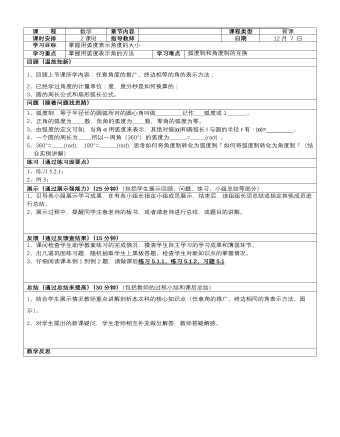
【高教版】中职数学基础模块上册:5.2《弧度制》优秀教案
课 程数学章节内容 课程类型新课课时安排2课时指导教师 日期12月 7 日学习目标掌握用弧度表示角度的大小学习重点掌握用弧度表示角的方法学习难点弧度制和角度制的互换回顾(温故知新)1、回顾上节课所学内容:任意角度的推广、终边相等的角的表示方法; 2、已经学过角度的计量单位:度,度分秒是如何换算的; 3、圆的周长公式和扇形弧长公式。问题(顺着问题找思路)1、弧度制:等于半径长的圆弧所对的圆心角叫做__________,记作____弧度或1________。 2、正角的弧度为_____数,负角的弧度为_____数,零角的弧度为零。 3、由弧度的定义可知,当角α用弧度来表示,其绝对值|α|和圆弧长l与圆的半径r有:|α|=________。 4、一个圆的周长为_____,所以一周角(360°)的弧度为_______=______(rad) 。 5、360°=_____(rad); 180°=_______(rad); 思考如何将角度制转化为弧度制?如何将弧度制转化为角度制?(结合实例讲解)练习(通过练习固要点)1、练习5.2.1; 2、例3;展示(通过展示强能力)(25分钟)(包括学生展示回顾、问题、练习、小组总结等部分)1、引导各小组展示学习成果,在有各小组长指定小组成员展示,结束后,该组组长须总结或指定其他成员进行总结。 2、展示过程中,提醒同学注意老师的板书,或者请老师进行总结,或题目的讲解。
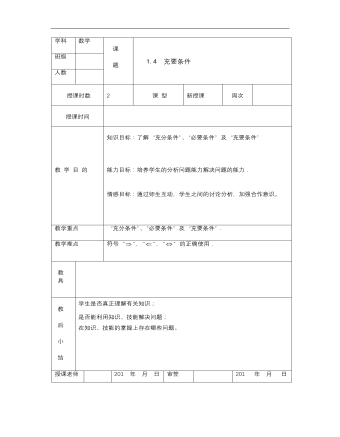
【高教版】中职数学基础模块上册:1.4《充要条件》优秀教案
学科数学 课 题 1.4 充要条件班级 人数 授课时数 2 课 型 新授课 周次 授课时间 教 学 目 的 知识目标:了解“充分条件”、“必要条件”及“充要条件” 能力目标:培养学生的分析问题能力解决问题的能力. 情感目标:通过师生互动,学生之间的讨论分析,加强合作意识。 教学重点“充分条件”、“必要条件”及“充要条件”.教学难点符号“”,“”,“”的正确使用. 教 具 教 后 小 结 学生是否真正理解有关知识; 是否能利用知识、技能解决问题; 在知识、技能的掌握上存在哪些问题。

【高教版】中职数学基础模块上册:5.5《诱导公式》优秀教案
教学目标:知识与能力目标:1.能够借助三角函数的定义及单位圆推导出三角函数的诱导公式 2.能够运用诱导公式,把任意角的三角函数的化简、求值问题转化为锐角的三角函数的化简、求值问题情感目标:1.通过诱导公式的探求,培养学生的探索能力、钻研精神和科学态度 2.通过诱导公式探求工程中的合作学习,培养学生团结协作的精神; 3. 通过诱导公式的运用,培养学生的划归能力,提高学生分析问题和解决问题的能力。 一导入:二、自学(阅读教材第110---112页,回答下列问题) 在直角坐标系下,角的终边与圆心在原点的单位圆相交于,则,(一)终边相同的角:终边相同的角的 公式一:_______ ________________(二)关于轴的对称点的特征: 。对于角而言:角关于轴对称的角为_______公式二:__________ _________ _________
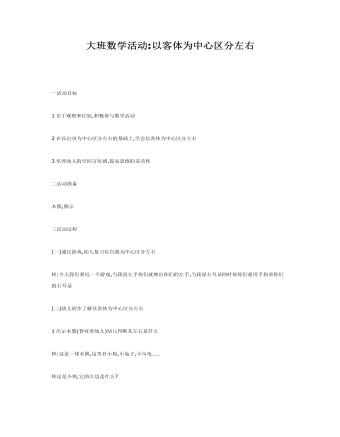
大班数学活动以客体为中心区分左右课件教案
2在以自身为中心区分左右的基础上,学会以客体为中心区分左右3培养幼儿的空间方位感,提高思维的灵活性二活动准备木偶,图示三活动过程(一)通过游戏,幼儿复习以自我为中心区分左右师:今天我们要玩一个游戏,当我说左手你们就伸出你们的左手,当我说右耳朵的时候你们就用手指着你们的右耳朵
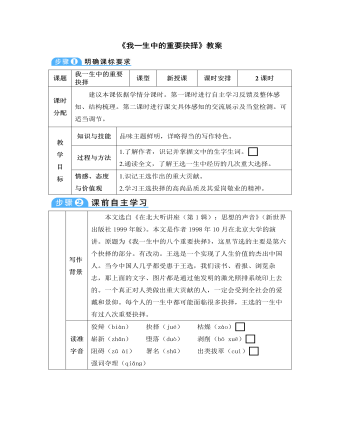
部编版语文八年级下册《我一生中的重要抉择》教案
(1)一个快落山的太阳,跟大家讲的,更多的是自己一生奋斗过来的体会。指61岁的老人。(2)加入人家说我是权威,也许还马马虎虎。作者自谦的说法,指成绩还过得去。(3)明明是一个过去时态,大家误认为是现在时态。指作者认为自己不适合再做权威了。(4)扶植年轻人我觉得是一种历史的潮流,当然我们要创造条件,就是把他们推到需要刺激的风口浪尖上。比喻重要的岗位或市场的前沿。【感悟精彩句子】1.所以我知道自己是一个下午四五点钟的太阳。各位呢,上午八九点钟的太阳,这是本科生;硕士生呢,九十点钟的太阳;博士生呢,十点十一点钟的太阳。比喻,拉近了与听众的距离,倍感亲切、期望和鼓舞。2.所以1992年前电视台采访我,我基本上都拒绝了。透过细节,体现了坚持不懈的科研精神。
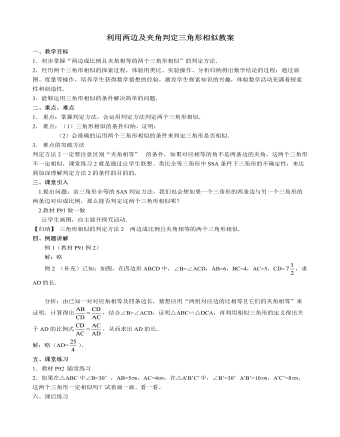
北师大初中数学九年级上册利用两边及夹角判定三角形相似2教案
一、教学目标1.初步掌握“两边成比例且夹角相等的两个三角形相似”的判定方法.2.经历两个三角形相似的探索过程,体验用类比、实验操作、分析归纳得出数学结论的过程;通过画图、度量等操作,培养学生获得数学猜想的经验,激发学生探索知识的兴趣,体验数学活动充满着探索性和创造性.3.能够运用三角形相似的条件解决简单的问题. 二、重点、难点1. 重点:掌握判定方法,会运用判定方法判定两个三角形相似.2. 难点:(1)三角形相似的条件归纳、证明;(2)会准确的运用两个三角形相似的条件来判定三角形是否相似.3. 难点的突破方法判定方法2一定要注意区别“夹角相等” 的条件,如果对应相等的角不是两条边的夹角,这两个三角形不一定相似,课堂练习2就是通过让学生联想、类比全等三角形中SSA条件下三角形的不确定性,来达到加深理解判定方法2的条件的目的的.
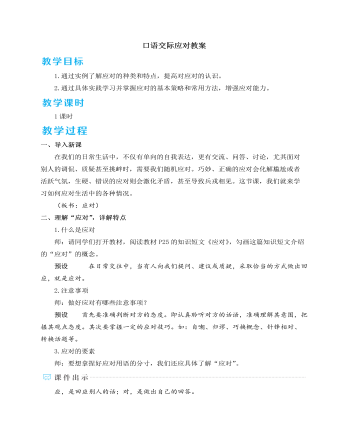
人教部编版语文八年级下册口语交际应对教案
(2)英国女士提出要见钱锺书,钱锺书既没有直接同意,也没有一口回绝,而是运用“类比法”,将自己的作品《围城》比作一个不错的“鸡蛋”,将自己比作下那个蛋的“母鸡”,用幽默的自嘲回绝了对方见面的请求,有礼有度,表现了大作家的聪明机智。(3)好的应对是依据语境,快速调动思维,迅速做出反应,做到随机应变、巧妙应对。案例中,年轻画家没有意识到自己画画的能力不够强,只是一味地抱怨画不好卖。门采尔快速调动思维,随机应变,变换了对方话语中的部分词语的语序,就巧妙地回答了年轻画家的问题,既给年轻画家点明了画卖得慢的原因,又指导了他该怎么做。师小结:在沟通与交流的过程中难免产生碰撞和冲突,如何让别人心服口服,话怎么讲才能让人听进去,这是值得我们思考与学习的。2.布置作业(1)任选一题完成:①找一个自己应对失败的例子,重新设计应对的语言。 如:好朋友想约你去网吧打游戏,你怎么应对?
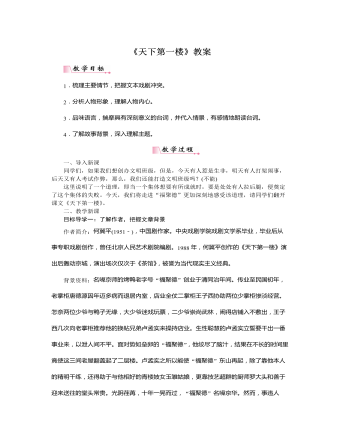
部编版语文九年级下册《天下第一楼》教案
明确:修鼎新的一句话“一个人干,八个人拆”是对上述情节最好的概括。从全文来看,唐茂昌与唐茂盛是只知出不知入的二世祖,成心要钱挥霍,且二少爷直接挖走店里的得力助手,这比坐吃山空的后果更加严重;罗大头是烤鸭一把手,克五又知道他藏着烟土,这无疑是罗大头将要出事的信号。且罗大头自恃烤鸭技艺离去,这对于“福聚德”无疑是有打击力的;此外,连小伙计都不成器。种种迹象,几乎都指向“福聚德”即将衰落。究其根本原因,可以说,这是勤劳务实的人与东家少爷、克五这样混吃混喝的人的矛盾,是平民与欺压平民的官僚之间的矛盾。这矛盾,才是“福聚德”真正衰落的原因。目标导学三:把握文本语言特征,理解含义深刻语句1.本文语言十分具有方言特色,甚至有些方言运用比较低俗,你如何看待这个问题?请结合文章做简要分析。
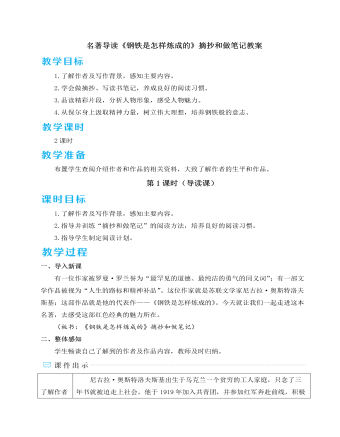
人教部编版语文八年级下册名著导读《钢铁是怎样炼成的》摘抄和做笔记教案
一团绿火像镁光似的在保尔眼前一闪,耳边响起了一声巨雷,烧红的铁片灼伤了他的脑袋。大地可怕地、不可思议地旋转起来,开始缓缓地向一旁倒下去。保尔像一根稻草似的被甩离了马鞍,越过马头,重重地摔倒在地。师:在那血与火的战争年代,保尔驰骋疆场,为革命事业浴血奋战,不惧牺牲。他那钢铁般的意志是在战火纷飞的疾苦中千锤百炼而成的。3.面对疾病师:病痛没有击垮保尔,面对自身的疾病,他是这样的——片段一:“……我受到一次又一次的打击。一次打击过后,我刚站起来,另一次打击,比上一次更无情的打击又来了。最可怕的是我无力反击。先是左臂不听使唤。这已经是够痛苦的了,谁知紧接着两条腿也不能活动。我原本就只能在室内勉强走动,现在甚至从床沿挪到桌子跟前也异常困难。可是,恐怕这还不算最糟的。明天会怎么样?谁也无法预料……”



